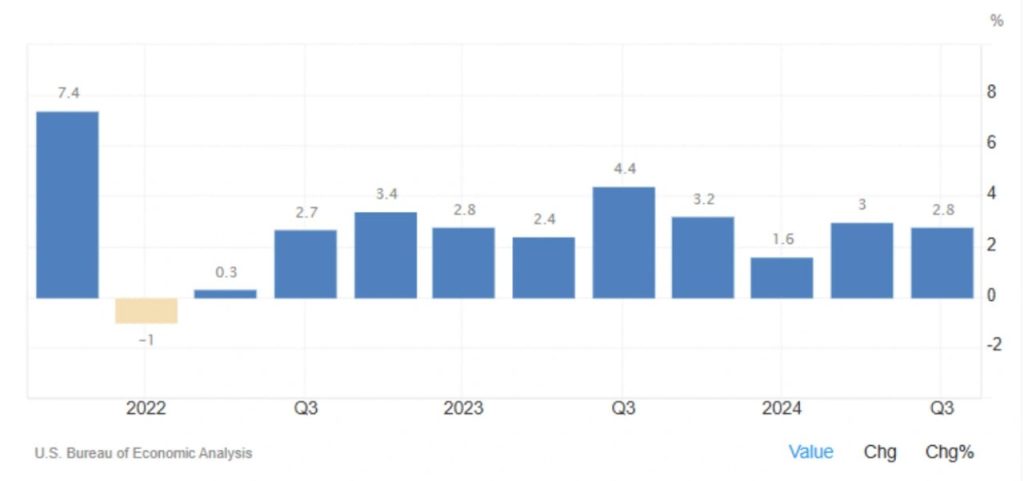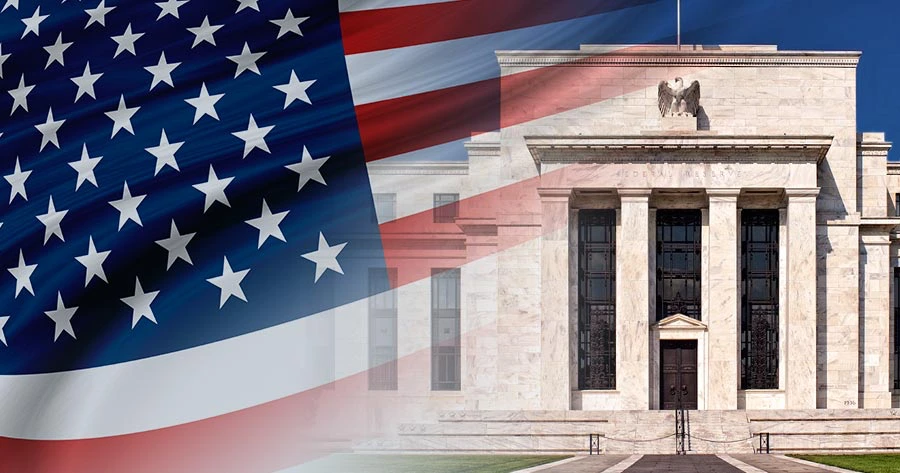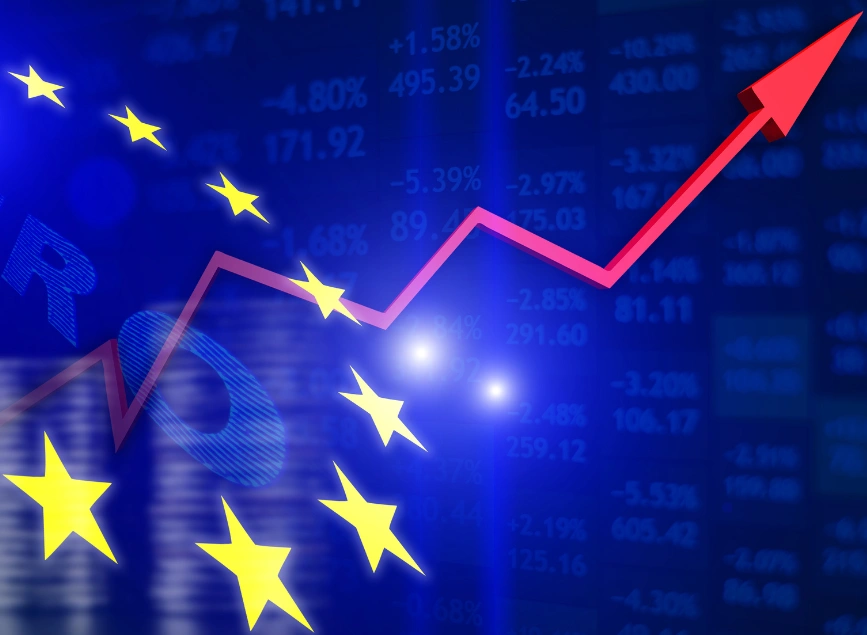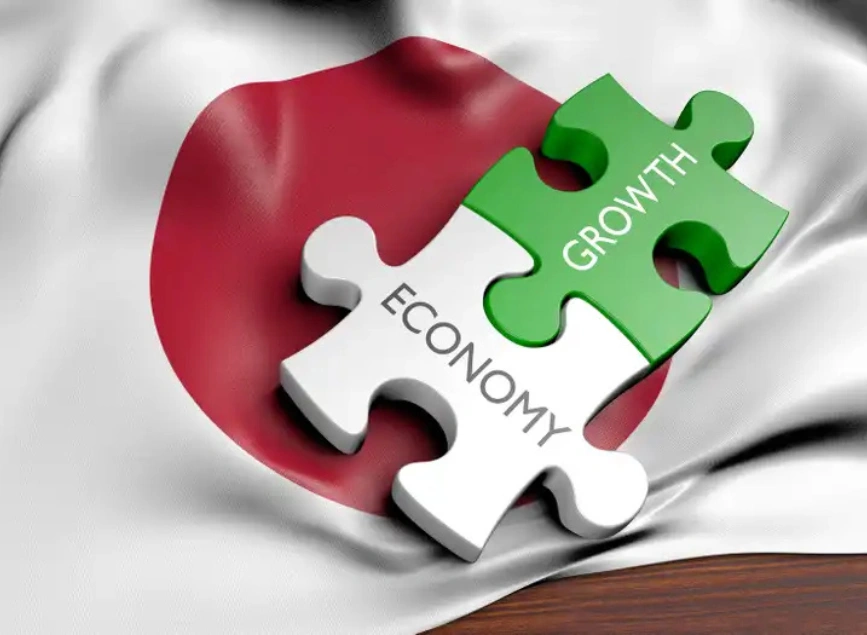
US Economy Expands by 2.8% in Q3 2024
The US economy maintained steady growth in the third quarter of 2024, expanding at an annualized rate of 2.8%. This pace matched the advance estimate but was slightly below the 3% growth seen in Q2. The economy’s performance was driven by strong consumer spending, solid government expenditures, and better-than-expected fixed investment. However, headwinds from net trade and inventories tempered the overall expansion. These results highlight a mixed economic picture as the country continues navigating global uncertainties and domestic challenges.

Strong Consumer Spending Drives Growth
Consumer spending, a major driver of economic growth, surged by 3.5% in Q3 2024, its fastest pace since early 2023. While slightly revised down from the initial 3.7% estimate, this robust performance underscores the strength of household demand. Goods consumption jumped by 5.6%, slightly lower than the 6% initially reported, fueled by strong purchases in sectors like durable goods and retail. Meanwhile, spending on services rose 2.6%, holding steady with the advance estimate, reflecting continued demand for experiences like dining, travel, and entertainment.
This resilience in consumer spending comes amid persistent inflationary pressures and higher borrowing costs, indicating that households are prioritizing expenditures despite economic challenges. However, with inflation and interest rates remaining elevated, sustaining this momentum may prove challenging in the coming quarters.
Trade and Inventories Weigh on Growth
Despite strong domestic demand, trade dynamics posed a challenge to growth. Net trade dragged on the economy, contributing -0.57 percentage points, slightly worse than the advance estimate of -0.56 points. Exports rose 7.5%, down from the initial 8.9% estimate, as global demand softened. Imports grew 10.2%, revised from 11.2%, reflecting strong domestic consumption but a continued trade imbalance.
Private inventories also acted as a small drag, subtracting 0.11 percentage points from growth. This was a smaller impact than the initially estimated 0.17-point reduction, suggesting that businesses are managing inventory levels cautiously amid uncertain demand. Together, these factors highlight the ongoing complexities of global trade and supply chain disruptions impacting the US economy.
Mixed Performance in Investments
Investment trends painted a mixed picture in Q3. Fixed investment grew by 1.7%, exceeding the earlier estimate of 1.3%, with businesses showing a stronger appetite for capital spending. Equipment investment surged by 10.6%, indicating a focus on upgrading machinery and technology to enhance productivity. However, structural investment fell 4.7%, slightly more than the previous 4% decline, reflecting continued challenges in commercial real estate. Residential investment also dropped by 5%, a marginal improvement from the earlier -5.1%, as high mortgage rates and housing costs continued to weigh on the sector.
These mixed results show that while businesses are investing in growth-oriented areas, challenges in construction and housing persist, limiting broader investment gains. As interest rates remain elevated, further improvements in these sectors may depend on easing financial conditions.
A Balanced Economic Outlook
The Q3 2024 results highlight the resilience of the US economy in the face of significant global and domestic challenges. Strong consumer demand and solid business investment have kept growth steady, but trade imbalances, inflation, and high interest rates continue to pose risks. Government spending, which grew 5% during the quarter, remains a stabilizing factor, supporting economic activity across various sectors.
Looking ahead, the interplay between robust consumer activity and persistent challenges in trade and housing will be key in determining the trajectory of the economy in Q4 and beyond. Policymakers and businesses will closely monitor these dynamics to adapt strategies that sustain growth and mitigate potential risks. For now, the US economy’s steady expansion provides a foundation for cautious optimism as it navigates an increasingly complex landscape.
Share
Hot topics

Federal Reserve’s Challenges to Trump’s New Policies
As the Federal Reserve Open Market Committee (FOMC) prepares for its upcoming meeting, all eyes are on how the Fed will respond to Donald Trump’s latest economic policies. With the...
Read more




Submit comment
Your email address will not be published. Required fields are marked *